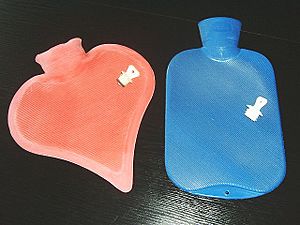Heat conduction facts for kids

Heat conduction is how heat moves from one object to another when they are touching. Imagine you touch a hot-water bottle. The heat from the bottle moves directly into your colder hands. This is heat conduction! The heat always travels from the warmer object to the cooler one.
People use this idea to make many things. For example, cooking pots are made of materials that conduct heat well, so your food gets hot quickly. But insulated cups are made of materials that do not conduct heat well, keeping your hot drinks hot or cold drinks cold.
Heat can also move in other ways, like thermal radiation (heat from the sun) or convection (heat moving through liquids or gases). Often, all these ways of heat transfer happen at the same time.
Contents
How Heat Moves at a Tiny Level
Everything around us, like solids, liquids, and gases, is made of super tiny particles called atoms. These atoms are always moving or vibrating.
Atoms and Temperature
The temperature of something tells us how fast its atoms are moving. If something is hot, its atoms are vibrating very fast. If it's cold, they are moving more slowly. Heat is the total energy from all these vibrating atoms.
How Conduction Works
When one part of an object gets hot, the atoms in that part start vibrating faster. These fast-moving atoms bump into their neighboring atoms. When they bump, they pass some of their energy to the neighbors, making them vibrate faster too.
This bumping and passing of energy continues from atom to atom, like a chain reaction. This is how heat energy travels through a solid material. Think of it like a line of dominoes falling one after another – the energy moves along the line.
Conduction in Different Materials
Heat conduction is usually strongest in solids. This is because the atoms in solids are packed very close together and cannot move far from their spots. This makes it easy for them to bump into each other and pass on heat.
In liquids and gases, the atoms are more spread out and can move around freely. Because they are not as close, they do not bump into each other as often. This means heat conduction is usually slower and less important in liquids and gases compared to solids.
The Law of Heat Conduction
The law of heat conduction is also known as Fourier's law. It helps scientists and engineers understand how quickly heat moves through different materials.
What Fourier's Law Means
This law basically says that the amount of heat that moves through a material depends on a few things:
- How big the temperature difference is between the hot and cold parts. The bigger the difference, the faster the heat moves.
- The size of the area the heat is flowing through. A larger area means more heat can flow.
- The type of material itself. Some materials are good at letting heat pass through, while others are not. This is called their thermal conductivity.
Thermal Conductivity
Thermal conductivity is a measure of how well a material conducts heat. Materials with high thermal conductivity, like metals, let heat pass through easily. Materials with low thermal conductivity, like wood or plastic, are good insulators and slow down heat transfer.
Related pages
Images for kids
See also
 In Spanish: Conducción de calor para niños
In Spanish: Conducción de calor para niños


